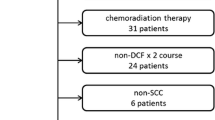Abstract
Background
In Japan, positron emission tomography using 18F-fluorodeoxyglucose (FDG-PET) has been covered by the national health insurance for esophageal cancer since 2006. FDG-PET is commonly performed in advanced esophageal cancer. The aim of this study was to determine the effect of FDG-PET on survival in patients with locally advanced inoperable esophageal cancer.
Methods
We retrospectively reviewed all patients with cT4 and without M1 esophageal cancer on CT in our institution between 2000 and 2014, and data for 78 patients who meet the eligibility criteria described below were used for analysis in this study. The eligibility criteria included (1) cT4 esophageal cancer without distant metastases or M1 lymph node metastasis (UICC 2002), (2) histologically proven squamous cell carcinoma, (3) 20–79 years of age, (4) having undergone at least 1 cycle of concomitant chemotherapy, (5) having been irradiated with 50 Gy or more, and (6) no other active malignant tumor during treatment.
Results
Two patients were excluded because abdominal lymph node metastases or neck lymph node metastases were detected by FDG-PET. In 78 eligible patients, FDG-PET was not performed before treatment in 41 of the 78 patients and was performed in the other patients. The median observation period was 68 months. The 3-year and 5-year overall survival rates in 78 patients were 36.9% and 30.8%, respectively. There was no significant difference in overall survival or progression-free survival between patients in whom FDG-PET was performed and those in whom FDG-PET was not performed (12.0 months vs. 11.0 months, p = 0.920 and 6.0 months vs. 6.0 months, p = 0.844, respectively).
Conclusions
Compared with only CT, additional information from FDG-PET is not associated with improving survival in patients with locally advanced esophageal cancer. Our results suggest that FDG-PET might not have much meaning for survival in locally advanced esophageal cancer.




Similar content being viewed by others
Abbreviations
- FDG-PET:
-
Positron emission tomography using 18F-fluorodeoxyglucose
- GTV:
-
Gross tumor volume
- CTV-p:
-
Clinical target volume for the primary lesion
- PTV:
-
Planning target volume
- CDDP:
-
Cisplatin
- 5-FU:
-
5-Fluorouracil
- DOC:
-
Docetaxel
- CDGP:
-
Nedaplatin
- OS:
-
Overall survival
- PFS:
-
Progression-free survival
- CI:
-
Confidence interval
- \({\text{SU}}{{\text{V}}_{{\text{max}}}}\) :
-
Maximum standardized uptake value
References
Ferlay J, Soerjomataram I, Ervik M et al (2012) GLOBOCAN 2012: estimated cancer incidence, mortality and prevalence worldwide in 2012. International Agency for Research on Cancer (IARC), Lyon
Barber TW, Duong CP, Leong T et al (2012) 18F-FDG PET/CT has a high impact on patient management and provides powerful prognostic stratification in the primary staging of esophageal cancer: a prospective study with mature survival data. J Nucl Med 53(6):864–871
Wong R, Walker-Dilks C, Raifu A (2012) Evidence-based guideline recommendations on the use of positron emission tomography imaging in oesophageal cancer. Clin Oncol (R Coll Radiol) 24(2):86–104
Katsoulis IE, Wong WL, Mattheou AK et al (2007) Fluorine-18 fluorodeoxyglucose positron emission tomography in the preoperative staging of thoracic oesophageal and gastro-oesophageal junction cancer: a prospective study. Int J Surg 5(6):399–403
Gillies RS, Middleton MR, Maynard ND et al (2011) Additional benefit of 18F-fluorodeoxyglucose integrated positron emission tomography/computed tomography in the staging of oesophageal cancer. Eur Radiol 21(2):274–280
Metzger JC, Wollschläger D, Miederer M et al (2017) Inclusion of PET-CT into planning of primary or neoadjuvant chemoradiotherapy of esophageal cancer improves prognosis. Strahlenther Onkol 193(10):791–799
van Westreenen HL, Westerterp M, Sloof GW et al (2007) Limited additional value of positron emission tomography in staging esophageal cancer. Br J Surg 94:1515–1520
Jingu K, Umezawa R, Matsushita H et al (2016) Chemoradiotherapy for T4 and/or M1 lymph node esophageal cancer: experience since 2000 at a high-volume center in Japan. Int J Clin Oncol 21(2):276–282
Chen SW, Hsieh TC, Ding HJ et al (2014) Pretreatment metabolic tumor volumes to predict the short-term outcome of unresectable locally advanced squamous cell carcinoma of the esophagus treated with definitive chemoradiotherapy. Nucl Med Commun 35(3):291–297
Pan L, Gu P, Huang G et al (2009) Prognostic significance of SUV on PET/CT in patients with esophageal cancer: a systematic review and meta-analysis. Eur J Gastroenterol Hepatol 21(9):1008–1015
Nishimura Y, Jingu K, Itasaka S et al (2016) Clinical outcomes of radiotherapy for esophageal cancer between 2004 and 2008: the second survey of the Japanese Radiation Oncology Study Group (JROSG). Int J Clin Oncol 21(1):88–94
Acknowledgements
This paper was presented at the 12th Congress of the World Federation of Nuclear Medicine and Biology to be held during 20–24th April 2018 in Melbourne.
Funding
Not applicable.
Author information
Authors and Affiliations
Contributions
KJ, HM and KT participated in the design of the study, performed treatment, collected the data and drafted the manuscript; RU, TY, YI and NT and KT participated in the design of the study, performed treatment, and collected the data; and NK participated in the design of the study and performed treatment.
Corresponding author
Ethics declarations
Conflict of interest
The authors declare that they have no competing interests.
Ethics approval and consent to participate
The present study protocol was reviewed and approved by Ethics Committee of Tohoku University Graduate School of Medicine (2014-1-541), and written informed consent for definitive chemoradiotherapy was obtained from each patient before conducting the treatment.
Availability of data and material
All data generated or analyzed during this study are included in this published article.
Additional information
Publisher’s Note
Springer Nature remains neutral with regard to jurisdictional claims in published maps and institutional affiliations.
About this article
Cite this article
Jingu, K., Umezawa, R., Yamamoto, T. et al. FDG-PET might not contribute to improving survival in patients with locally advanced inoperable esophageal cancer. Int J Clin Oncol 24, 927–933 (2019). https://doi.org/10.1007/s10147-019-01428-8
Received:
Accepted:
Published:
Issue Date:
DOI: https://doi.org/10.1007/s10147-019-01428-8




